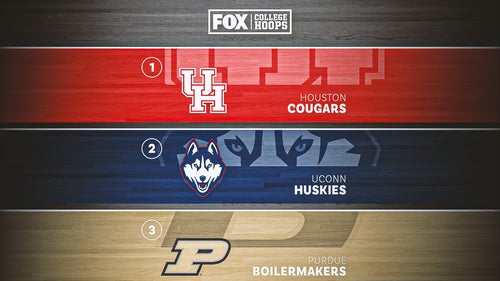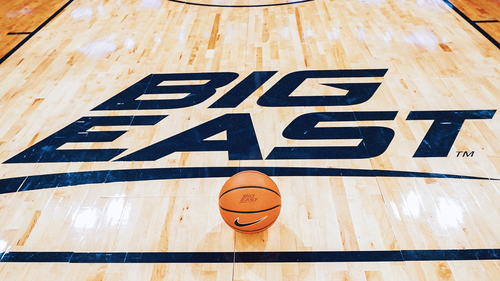[ad_1]
Four weeks ago, after another hard-fought Big Ten game between a team ranked 10th in the nation and an opponent desperate to find its footing, Illinois head coach Brad Underwood elicited a laugh from the collection of reporters chronicling his news conference at the Breslin Center. The Illini had squandered a late lead and fallen to unranked Michigan State, 88-80, in the kind of game that gave visual representation to the league standings: a logjam of teams who are treading water in a race dominated by Purdue.
Underwood was asked what delineates winning and losing in a conference as cannibalistic as the Big Ten. In other words, which common factors are deciding games on a nightly basis in the Midwest?
“Zach Edey,” Underwood quipped. “You want an honest answer? We’re all equal. We all have really good players, we have really good coaches and we have great venues.”
Except, of course, for Edey. No player across the sport has been more dominant than Edey the last two years. Purdue’s hulking 7-foot-4, 300-pound center averaged 22.3 points and 12.9 rebounds per game during the 2022-23 campaign to be named the Naismith Men’s College Player of the Year. He feels like a shoo-in to win the award again this season while averaging 24.1 points and 11.7 rebounds for a group of Boilermakers likely to earn a No. 1 seed in the NCAA Tournament.
If — or when — Edey wins the award, he’ll join an incredibly exclusive group of players to have received the honor multiple times. Former UCLA center Bill Walton did it on three occasions in 1972, 1973 and 1974. Former Virginia center Ralph Sampson matched that feat by winning in 1981, 1982 and 1983. Nobody else has won the Naismith award more than once.
With Edey on the verge of joining Sampson and Walton as multi-time winners, FOX Sports spoke with Sampson — who is also 7-foot-4 — about the Naismith award, his place in college basketball history and the role of big men in the modern game.
(Note: This interview has been lightly edited for length and clarity.)
Do you remember your emotions when winning the Naismith College Player of the Year award for the first time and what that meant for you?
Sampson: “My second year in college, we went to the Final Four that year, but I recall basically from my freshman year to my sophomore year, I was 7-foot-1. I grew three inches that year to 7-foot-4. I was awkward. I had gained like 15 extra pounds of muscle. So I worked my tail off between the first year and the second year and got stronger, bigger, faster because I knew I could play at that level, because we went to the NIT and won that Championship against Minnesota. And they had Kevin McHale, Randy Breuer and a bunch of pro athletes, so it was cool. But I just knew that if I worked hard enough, I could achieve that. So the second year I got that Player of the Year award, and it was fun to go to Philadelphia to the Final Four, get that award there. So that started my hunger for just playing at a very high level. Now, I never played for the Player of the Year Awards, I always played for championships. But to get that award three times was very special, and each time was different in its own way, you know? First time in Philly, second time [in New Orleans], my last year was in Albuquerque, New Mexico, when N.C. State won it. So it was special each time. It’s totally different each time you do it, you know? You can expect that you’ll get a trophy — OK great, get an award — but just the atmosphere of the award itself is very special.”
What was it like to be 7-foot-4 in that era of basketball, when there was no 3-point line, there weren’t people stretching the defense the way they do now?
Sampson: “Ah, yeah, we wish it was that way back then, right? The 7-footer can shoot 3s. I was, as they say, maybe before my time because I could shoot 3s, I could dribble, I could do all those things. But I worked on that in high school. And the reason I was able to work on that and do that was my high school coach, Roger Bergey, [was] a great, great innovator of the game, let me do it in practice against the guards because I couldn’t get the ball. Everybody wanted to play a box-and-1, triangle-and-2, I could never get the ball, I had to get rebounds. So I got frustrated and I would turn it over in the game. And he would say, ‘If you can do it in practice, you can do it in the game.’ So he taught me how to do it in practice. I worked on it religiously every day and I could dribble, and that’s where I got really good at it. Then it just kind of carried over into high school and the NBA. But stretching the game today with big guys, I mean, it’s coming. But I think the evolution of the big guys, and the one we’re speaking about [Edey], it’s going to come back more to the mid-post, low-post era, high pick-and-roll type situations where the big man will come back in some shape or form like it was in the past. But it won’t ever be like it was.”
What was the most unusual or most creative defensive strategy you saw used against you by opposing coaches trying to shut you down?
Sampson: “Ah, it was all over. I have a picture [from when] we were playing North Carolina, so there’s Michael Jordan in front of me, Sam Perkins behind me and James Worthy is on the other side. So it was like you’ve got all three trying to guard me. I had really, really good teammates, but we didn’t have … a pure shooter. My first couple years, we had Jeff Lamp who could shoot the ball really, really well. The other couple years, we had great athletes. Rick Carlisle could shoot, the coach of the Pacers. But everybody collapsed on me as I look at pictures from the past. I didn’t really realize it until I started looking at that. And [opponents] made [my teammates] beat them and shoot it. But I had a great cast of characters. That year we played Georgetown and Patrick [Ewing in a regular season game in 1982], I mean, I got my points but teammates played great defense and they hit some open shots when we needed it. So it was a good mixture back then, but to be able to do that today, I think it’s crazy how the game has changed.”
There are pictures of Zach Edey now after a game where his arms will have scratches all over him. People are pulling at his jersey and everything. What did your body feel like in those games?
Sampson: “I mean, he’s a big, big guy as well. You get beat up. I mean, think about, he’s getting scratched or whatever the way he’s playing in that more low-post position. So you’ve got everybody coming to him, you’re setting picks under there, somebody is going to run into you, they’re going to hit you, they’re going to try to bully you and see if you wanna fight to get out the game. So being his size, you know, I equate that to Wemby [Victor Wembanyama] and all the big guys that are playing now. You take a physical beating no matter what you do. I know the guards take physical beatings too if they’ve gotta run off picks with big guys. Back in the day Rick Mahorn and the Bruise Brothers with Detroit, I mean, they were headhunting guys, I get it. But big guys are going to take that beating: scratches, bruises, step on your feet because I wore a size 17. I mean, you’re going to get all of that. It’s part of the game, but it’s tough under that basket.”
This is the second year in a row where Edey has averaged at least 22 points and approximately 12 rebounds. What goes through your mind when you watch the way he plays?
Sampson: “I watch a lot of college basketball, obviously, but I told somebody before that he’s a big guy and the coaches up there [at Purdue] really know how to handle him. I think they’ve done an extraordinarily great job. If I’m thinking about right now, I wish myself — or I have sons that are 6-foot-11 — so that big guys could teach the big guys. Because today you’ve got guards teaching big guys in the NBA about analytics, but you don’t understand that bruising and the physicalness of the game that you get if you’re not a big guy. So you’ve got to have a different mentality. I think his mentality is great. But I think he’s a better Mark Eaton-style player. If you kind of compare bodies, he’s that style of big guy. But he plays probably 100% better than Mark Eaton (7-4, 275 pounds).
When I came into the league, you had Elvin Hayes, Caldwell Jones, all those old-school guys who said, ‘You think you’re big, you think you’re tall. But you ain’t seen the mammoth, you ain’t seen the mountain: Mark Eaton.’ I said, ‘Who is this Mark Eaton guy?’ Because I didn’t know who he was. And they would say, ‘Well, when you go to Utah, you’re going to find out.’ So I go on the court and he walks in and I said, ‘Oh my gosh, he’s huge.’ At that point I said, ‘So how do I defend him, how do I maneuver around him offensively?’ And I have a picture as well of me against him, and I’m blocking his shot, and he’s still way above me but I had my fingertips on the ball. But he’s so, so big and so strong — and he wasn’t athletic. Edey is athletic. So the difference between size and being athletic. He can most likely do some damage in the game. Again, his skill set has got to improve at the NBA level to be able to play at that level, which it will if he gets with the right time. He’s going to be amazing to watch. And you think about [Chet] Holmgren and Wemby and all the big guys in the league coming up — [Joel] Embiid and all these guys coming up — the big guy, I think, is going to get ready to take a surge and come back a little bit more than it’s been over the last couple of years.”
One of the things that Edey is trying to do this year is have the NCAA Tournament success that people like you and Bill Walton had in similar positions. He hasn’t gotten there yet. When you thought about your legacy, what meant more to you: the championships, the Final Four or the individual Naismith awards?
Sampson: “After you finish playing at that level, you look back at everything. I mean, you want to win a championship. I mean, you’re in the midst of it. That’s the right thing for him to think right now. But he’s not going to look back on one Player of the Year award or two Player of the Year awards. He’s going to enjoy that, but he’s not going to say or want to think that he’s just playing for those awards. Because nobody who ever got that award on a personal level ever though that they would get an award. And now [in terms of] back to back, I mean, he’s not thinking about that award. He’s thinking about winning a championship, which is the way he should be thinking. And you never know what’s going to happen in the NCAA Tournament, so that’s where the beauty of the game is. But he will look back years later and say, ‘I appreciate that.’ But he should enjoy the experience of anything he gets because you only go through that life once. It’s college for four years or two years or whatever you stay, so enjoy every minute of it because it goes by so fast and you’ll back and say, ‘I should have did this, I should have done that.’ Never should he say he should have, would have, could have.”
When you won the second Naismith award and the third Naismith award, did you hear from Bill Walton? You guys are the only two that have ever done it three times. Edey would only be the third guy to even have done it twice. That’s a very small fraternity.
Sampson: “It’s only three of us in the fraternity, which is kind of crazy. I’ve sat down with the likes of Kareem Abdul-Jabbar my second year. I did speak to Bill Walton, I think, a couple times during the course of my career. I had the chance to speak to Bill Russell in my college career. A lot of great NBA legends that I spoke to while I was at UVA, so it was a very special time for me. The one that stands out the most is Bill Russell, [who won multiple Player of the Year awards in college at San Francisco before the Naismith came into existence]. I did an interview with him in college for a radio show, and he kind of just explained things to me back in his day, in that era, or whether it was earlier on. And I got the great opportunity when I was in the NBA to play for him when he was the general manager of the Sacramento Kings. And then we built this relationship after the fact. One of the great stories about him [is that] he was a player, a coach and then he got into the Hall of Fame the second time as a coach after so many years.
“It was a number of years ago when he drove from Seattle, with his wife, to Boston. They drove and just took a tour of the country. And then they came from Boston to Virginia and Virginia to Atlanta. They came down Atlanta, spent a couple days with me and my mom and dad. I still have the pictures. He went to Atlanta and stayed with Dominique [Wilkins] and all the people he cherished. And I was one of those people that he stopped and saw. So to me, obviously that warmed my heart. People talk about the GOAT, the greatest player — Bill Russell is the greatest to ever play the game because of the era, because of the championships and what he means to the NBA overall. Now there are some great players, don’t get me wrong, but I think he’s No. 1.”
Michael Cohen covers college football and basketball for FOX Sports with an emphasis on the Big Ten. Follow him on Twitter at @Michael_Cohen13.
recommended

Get more from College Basketball Follow your favorites to get information about games, news and more
[ad_2]
Source link













